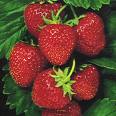health Benefits strawberry
28 07 2009
Health Benefits
Strawberries not only look like a fruity heart-shaped valentine, they are filled with unusual phytonutrients that love to promote your health.
Potent Antioxidant Protection from Phenols
Strawberries, like other berries, are famous in the phytonutrient world as a rich surce of phenols. In the strawberry, these phenols are led by the anthocyanins (especially anthocyanin 2) and by the ellagitannins. The anthocyanins in strawberry not only provide its flush red color, they also serve as potent antioxidants that have repeatedly been shown to help protect cell structures in the body and to prevent oxygen damage in all of the body’s organ systems. Strawberries’ unique phenol content makes them a heart-protective fruit, an anti-cancer fruit, and an anti-inflammatory fruit, all rolled into one. The anti-inflammatory properties of strawberry include the ability of phenols in this fruit to lessen activity of the enzyme cyclo-oxygenase, or COX. Non-steriodal anti-inflammatory drugs like aspirin or ibuprofen block pain by blocking this enzyme, whose overactivity has been shown to contribute to unwanted inflammation, such as that which is involved in rheumatoid and osteoarthritis, asthma, atherosclerosis, and cancer. Unlike drugs that are COX-inhibitors, however, strawberries do not cause intestinal bleeding.
Strawberry Phytonutrients that Promote Optimal Health
The ellagitannin content of strawberries has actually been associated with decreased rates of cancer death. In one study, strawberries topped a list of eight foods most linked to lower rates of cancer deaths among a group of over 1,000 elderly people. Those eating the most strawberries were three times less likely to develop cancer compared to those eating few or no strawberries.
A study published in the Journal of Agriculture and Food Chemistry analyzed eight strawberry cultivars for their content of protective plant compounds (phenols, flavonoids and anthocyanins) and their antioxidant capacities. Although the various cultivars differed significantly in the amounts of the various beneficial compounds each contained, all cultivars (Earliglow, Annapolis, Evangeline, Allstar, Sable, Sparkle, Jewel, and Mesabi) were able to significantly inhibit the proliferation of human liver cancer cells. Interestingly, no relationship was found between a cultivar’s antioxidant content and its ability to inhibit cancer cell proliferation, which suggests that this beneficial effect of strawberries is caused by other actions of their many beneficial compounds.
Protection against Macular Degeneration
Your mother may have told you carrots would keep your eyes bright as a child, but as an adult, it looks like fruit is even more important for keeping your sight. Data reported in a study published in the Archives of Ophthalmology indicates that eating 3 or more servings of fruit per day may lower your risk of age-related macular degeneration (ARMD), the primary cause of vision loss in older adults, by 36%, compared to persons who consume less than 1.5 servings of fruit daily.
In this study, which involved over 110,000 women and men, researchers evaluated the effect of study participants’ consumption of fruits; vegetables; the antioxidant vitamins A, C, and E; and carotenoids on the development of early ARMD or neovascular ARMD, a more severe form of the illness associated with vision loss. While, surprisingly, intakes of vegetables, antioxidant vitamins and carotenoids were not strongly related to incidence of either form of ARMD, fruit intake was definitely protective against the severe form of this vision-destroying disease. Three servings of fruit may sound like a lot to eat each day, but strawberries can help you reach this goal. Top your morning cereal, lunch time yogurt or cottage cheese with fresh strawberries. Dress up any green salad with sliced strawberries, slivered almonds and
Comments : Leave a Comment »
Categories : Uncategorized
Hello world!
14 07 2009Welcome to WordPress.com. This is your first post. Edit or delete it and start blogging!
Comments : 1 Comment »
Categories : Uncategorized





